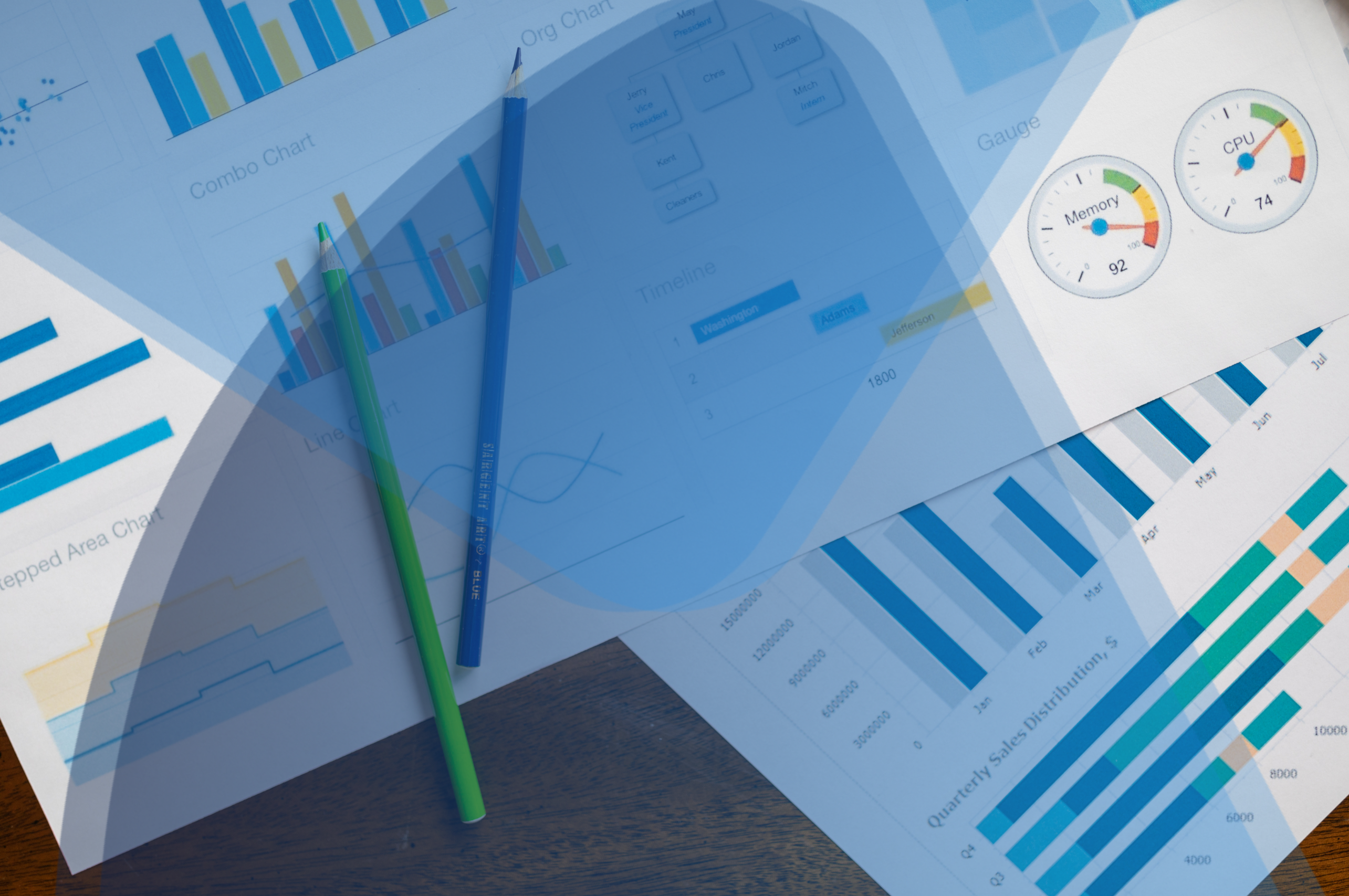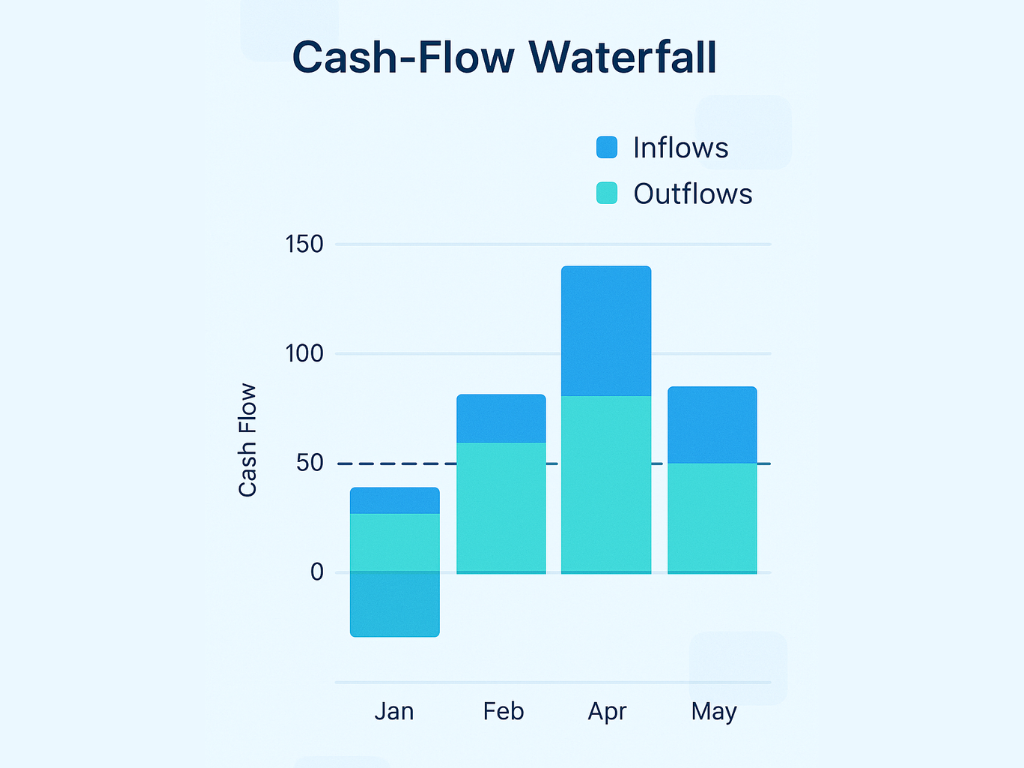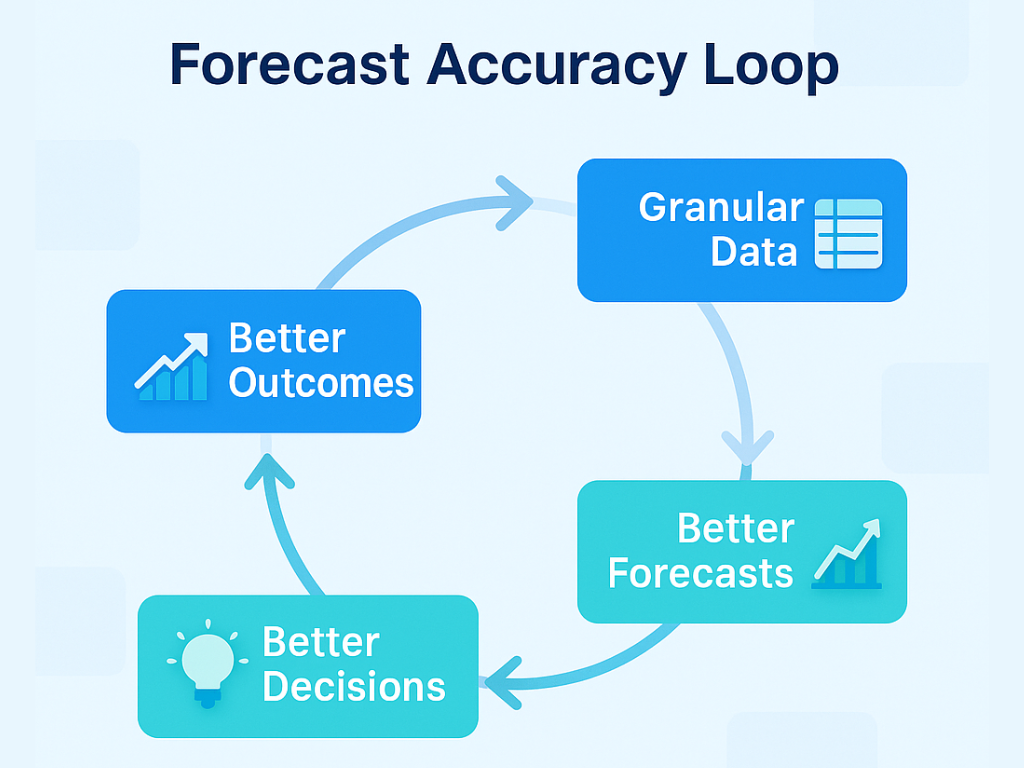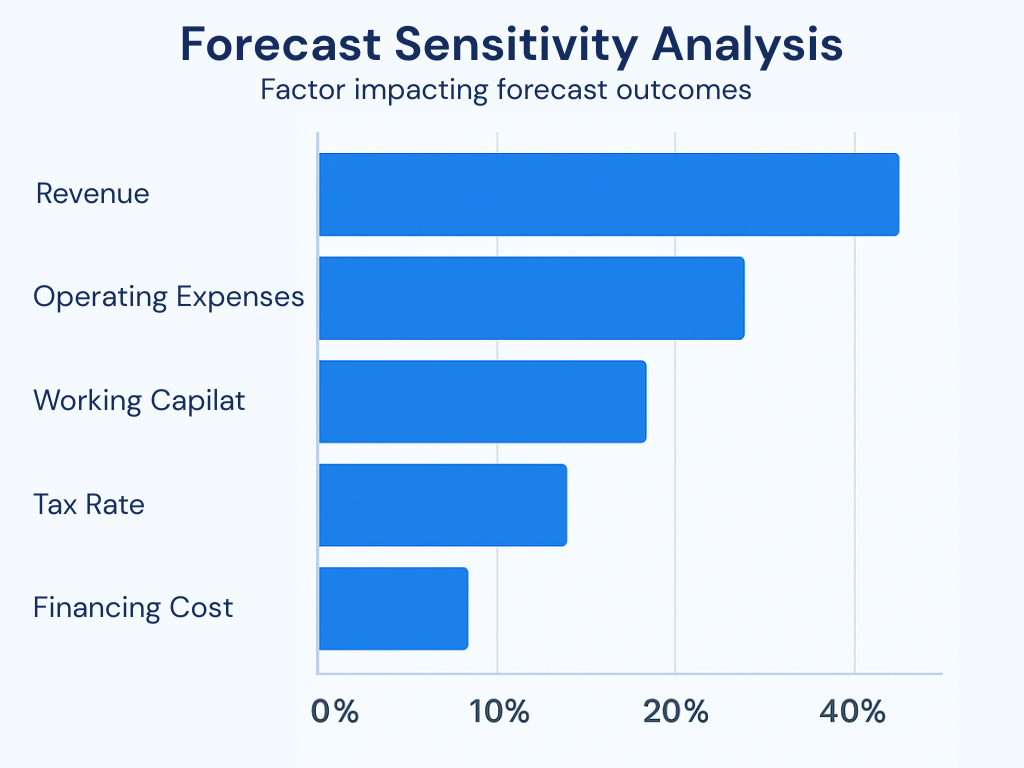Accurate Cash Flow Forecasting: How Granular Data Improves Liquidity and Reduces Risk
Table of Contents
Why disciplined tracking of actual cash movements turns cash-flow forecasting from hopeful ritual into economic science
Tracking all the money flowing in and out of your business is essential for comprehensive financial planning, as it allows you to list and monitor every expense and income source to understand your total outgoings and manage budgets effectively. Accounting software is commonly used by finance teams to efficiently ingest and manage historical and transactional data during the cash forecasting process. In particular, tracking cash coming into your business is a key part of monitoring cash flow and supports accurate cash forecasting. Typically, finance and treasury teams are responsible for gathering data from various stakeholders and financial systems to determine future cash positions.
Cash forecasting is a crucial component of liquidity forecasting, enabling businesses to ensure they can meet their short-term obligations and maintain financial stability.
Disciplined tracking of actual cash movements not only enhances the accuracy of your cash-flow forecasts but also supports effective cash management by providing the data necessary for informed decision-making and risk mitigation.
Why “good-enough” cash forecasts still fail
Forecasting is the cornerstone of financial planning and plays a critical role in cash flow planning and liquidity planning, yet most companies still wake up to cash shortages. The culprit is rarely a lack of sophistication; it is the absence of timely, trustworthy cash flow data. Forecasts built on stale numbers devolve into guesswork, leaving leaders blind to brewing gaps in inflows and outflows. Finance teams are responsible for gathering accurate historical data and supporting the cash forecasting process, ensuring projections are reliable for decision-making. Treasury teams play a central role in monitoring cash positions, maximizing investments, minimizing expenses, and supporting strategic decision-making through accurate cash forecasts and liquidity management. To replace astrology with analytics, the treasury must anchor predictions in live transactions and continually interrogate key assumptions.
What is Cash Flow Forecasting?
Cash flow forecasting is the process of predicting the movement of cash into and out of a business over a specific period. It’s a foundational tool in financial planning, giving businesses a forward-looking view of their liquidity and enabling them to anticipate both opportunities and challenges.
To create a cash flow forecast:
-
Identify the planning period
-
List all income
-
List all outgoings
-
Calculate running cash flow.
Modern cash forecast tools utilize analytics and historical data to generate more accurate cash flow projections, thereby supporting informed financial decision-making. Cash flow projections use historical sales data and expense forecasts to inform financial decision-making.
By estimating future cash flow, companies can make informed decisions about when to invest, when to hold back on spending, and how to prepare for upcoming obligations. Whether you’re planning for growth, managing day-to-day operations, or navigating uncertain market conditions, cash flow forecasting provides the visibility needed to keep your business on solid financial ground. Cash flow forecasting also supports liquidity analysis by helping companies to assess their ability to meet short-term obligations. For most businesses, understanding future cash is the difference between seizing new opportunities and scrambling to cover shortfalls. Cash flow is the lifeblood of any business.
The anatomy of cash flow: more than just numbers
At its core, cash flow comprises three critical components: cash inflows, cash outflows, and cash positions. Cash inflows are the funds entering your business, thinking revenue from sales, incoming loan payments, and tax refunds. Cash outflows refer to the payments made, including operating expenses, accounts payable, and debt repayments. Your cash position is the real-time balance of cash available to the business at any given moment. Accurate cash forecasting depends on understanding and tracking these elements in detail. By monitoring where cash is coming from and where it’s going, businesses can spot trends, anticipate needs, and ensure they always have accurate cash data to support decision-making.
Benefits and Objectives: Why Accurate Cash Forecasts Matter
Accurate cash forecasts are more than just a financial exercise. They’re a strategic advantage. With reliable cash flow forecasts, businesses can identify potential cash shortages before they become crises, ensuring they always have sufficient cash to meet payroll, pay suppliers, and fund growth. Effective cash flow forecasting supports financial planning by highlighting when and where cost cutting may be needed, and by identifying the best times to invest in strategic initiatives. The main objectives are to predict future cash flows with precision, improve forecast accuracy over time, and empower leaders to make informed decisions. To calculate net cash flow, subtract anticipated cash outflows from expected cash inflows for each period. Ultimately, mastering cash forecasting enables businesses to avoid cash shortages, optimize their working capital, and remain agile in the face of change.
Understanding Cash Inflows: The Lifeblood of Forecasting
When it comes to cash flow forecasting, cash inflows are the foundation on which every reliable projection is built. Without a clear understanding of where your money is coming from and when it’s expected to arrive even the most sophisticated cash flow forecasts can quickly unravel. For most businesses, cash inflows represent the lifeblood that sustains operations, funds growth, and supports strategic decision-making.
Cash inflows typically include revenue from sales, customer payments, loan proceeds, investment income, and occasional windfalls, such as tax refunds. Each of these sources can behave differently: some are predictable and recurring, while others are irregular or subject to market trends and seasonality. That’s why it’s essential to break down inflows by cash flow categories and business units, giving finance teams a comprehensive view of all the money entering the organization.
Accurate cash flow forecasting begins with capturing detailed and up-to-date cash flow data. Leveraging historical data helps identify patterns in customer payments, spot seasonal peaks, and anticipate the impact of future sales or market conditions on cash inflows. For example, analyzing previous years’ transactional data can reveal which clients consistently pay on time and which tend to delay, allowing for more precise cash flow projections.
Modern accounting software and financial systems can automate the collection and categorization of cash inflows, reducing manual work and improving forecast accuracy. By integrating real-time data feeds, businesses can quickly spot deviations from expected inflows and adjust their cash flow forecasts accordingly. Scenario analysis and sensitivity analysis further strengthen cash flow planning by modeling the impact of changes in sales volume, payment terms, or market shocks on future cash inflows.
To ensure sufficient cash is always available, finance departments should regularly review and update their cash flow forecasts, paying close attention to the timing and reliability of each inflow source. This proactive approach helps identify potential cash shortages before they become critical, supports better-working capital management, and empowers leaders to make informed decisions about investments, loan payments, and strategic initiatives.
In short, understanding and forecasting cash inflows with discipline and detail is not just an accounting exercise it’s a vital tool for business resilience and growth. By treating cash inflows as the starting point for every cash flow projection, organizations can gain insights, improve forecast accuracy, and ensure they’re never caught off guard by unexpected gaps in liquidity.
The anatomy of cash flow: more than just numbers
A professional cash flow forecasting routine predicts every dollar that will enter or exit a business over a specific period; a cash flow forecast is a financial tool that outlines expected cash inflows, outflows, and the resulting net cash position, typically broken down by week or month. This net cash position also reflects the company’s liquidity position, which is crucial for meeting short-term obligations. Knowing when and why money moves allows firms to avoid emergency borrowing, unlock growth, and remain resilient during volatile market conditions.
Regular cash flow forecasts are essential for informed business decision-making and effective strategic planning.
Cash versus accrual: a binary lens on reality
Because cash either moves or it doesn’t, bank activity reveals truth faster than income statements smoothed by accrual rules. This clarity is essential for effective liquidity analysis, as it allows for a more accurate assessment of a company’s ability to meet short-term obligations. Mature treasuries go further, slicing flows by source (operations, investing, financing) and driver (pricing, collections, labour hours). That granularity upgrades cash forecasting from rear-view mirror to forward radar.
Data foundations: cash-flow statements decoded
A clean cash flow statement sorts every movement into logical cash flow categories operating, investing, financing and reconciles opening balances to closing balances. Coupled with automated feeds of transactional data, this structure provides the accurate picture on which everything else relies. This information is essential for effective liquidity management.
A 2020 study of 168 Italian listed companies showed that cash inflows tied to fixed-asset investments and net operating surplus explained 60 % of operating income variance four years later, whereas accrual earnings added minimal signal. Analyzing cash inflows and outflows from previous years can further improve the accuracy of cash flow statements and forecasts by providing valuable historical context.
Academic evidence: why disaggregated cash beats earnings
Replicating that study’s logic inside a corporate model means treating future sales as dated receipts, not as revenue events. This mirrors findings from a Harvard Business School working paper, which found that disaggregated operating cash flows predict future cash flows significantly better than earnings. When planners combine historical data with tagged transactions, they gain even more precision. A Kingston University study showed that component-level breakdowns of cash flows outperform aggregate models in predictive accuracy.
The economics of forecast accuracy
Lift accurate cash forecasting by just two percentage points and a $500 million firm could unlock millions in idle reserves freeing capital to repay debt early or fund the next strategic initiative. Academic research shows firms with more accurate forecasts optimize cash holdings more efficiently. Since cash buffers are costly insurance, better forecasting lets leaders reduce unnecessary reserves and make confident investment decisions. Finance teams using automation see 40% faster cash flow projections, according to PwC.
Building the accuracy feedback loop
An effective loop has four gears that together shrink forecast variance by 30–40% within three quarters returning working capital from the “rainy-day” drawer to productive use. Research published in the Journal of Accounting and Economics shows that analyst forecasts improve significantly when based on disaggregated cash flow inputs. Likewise, internal models grounded in transaction-level cash dynamics can reduce noise and enhance decision confidence.
Define granular categories
Split cash outflows into payroll, accounts payable, tax, and capex, while breaking inflows into customer, department, or unit level. This structure mirrors the one shown in the Kingston study, where component-level breakdowns significantly improved forecast precision. Granularity improves cause-effect clarity, giving planners levers to pull in advance. Notably, 29% of business failures stem from running out of cash, according to a CB Insights report, reinforcing the need for accurate liquidity forecasting.
Capture transactional data daily
Most forecasts stumble not because of macro assumptions, but because of stale or missing inputs. Labor is often the biggest driver of spend yet it’s the last to update. ClickTime helps organizations capture labor data in real time, transforming timesheets into a reliable feed of cost signals. That daily cadence, especially when captured before, helps finance flag deviations in project-level burn before they snowball into cash shortages. Daily granularity here supports liquidity accuracy everywhere.
Reconcile at source
Link every bank line to its originating document. Variances exposed within a day avoid the “time consuming month-end scramble” that plagues many businesses. Prompt reconciliation of transactions is a key part of liquidity reconciliation, ensuring accurate tracking of available funds.
Continuously refine assumptions
Hard-code habitual collection lags and supplier clusters. Over a longer period, these micro-adjustments compound into tangible accuracy gains. Continuous refinement of assumptions also helps organizations identify and respond to emerging liquidity trends.
Long-term projections: the strategic vantage
Twelve- to 36-month views true long term projections inform capital structure, debt tenor, and M&A timing. Incorporating a cash flow projection over these periods is essential for supporting strategic decision-making, as it helps organizations anticipate liquidity needs and align financial planning with long-term goals. The liquidity forecasting process plays a crucial role in supporting strategic decision-making and long-term financial planning by providing a structured approach to projecting future cash positions. A mere one-point accuracy improvement two years out can trim seven figures off annual interest rates.
Waterfall charts detect drift
Stack forecasts month on month; widening gaps reveal systemic optimism or hidden pessimism. These gaps may also indicate potential liquidity gaps that require attention. That visual nudge prompts the finance department to revisit drivers rather than accept drift.
Scenario analysis for stress and upside
Structured scenario analysis injects demand shocks, commodity spikes, or delayed tax refunds to test liquidity. Scenario analysis should also consider market trends as a key factor in preparing for different economic scenarios. Liquidity stress testing is an essential part of this process, helping organizations prepare for adverse scenarios. Mapping outcomes to concrete risk management actions closes the loop from model to mitigation.
Machine learning after data hygiene
Predictive algorithms deliver value only once charts of account are standardised and tags unified across subsidiaries; otherwise models learn noise. Standardized data also enables the effective use of liquidity forecasting tools, such as machine learning algorithms.
Medium-term forecasts: bridging strategy and execution
Rolling 12- to 18-month horizons true medium term forecasts translate strategic road-maps into cash reality. Because these windows straddle budgeting cycles, they provide early alerts when plan and balance diverge. Liquidity planning tools can help organizations translate strategic roadmaps into actionable medium-term cash forecasts.
Cash-flow projections for business growth
Growth eats cash first. Rolling 3 + 9 schedules (three months actual, nine months forecast) let planners: (1) spot gaps six to nine months out, (2) time capex with natural peaks, and (3) phase new markets so the business grows without overdraft roulette. Small business owners routinely cite cash visibility as more important than product innovation. Liquidity forecasting software can assist planners in managing cash needs as the business grows.
Short-term liquidity and cash positioning
One- to four-week forecasts answer, “Can we meet payroll Thursday?” By closely monitoring cash positions, organizations can ensure short-term liquidity and quickly identify potential surpluses or shortages. Live dashboards contrast today’s opening balance with receipts and wires, flashing alerts inside the cash positioning workspace instead of the inbox. Collections rhythms matter: a top-ten debtor may always pay at +45 days, while 65 % of vendors bill on the 25th-28th.
Negative-cash-flow triage: fixing the leak fast
When the model flags an impending negative cash flow, triage follows three steps: (a) verify data integrity, (b) negotiate payment timing, (c) trigger contingency funding. Triggering contingency funding is part of the organization’s liquidity contingency plan, ensuring a structured response to liquidity emergencies. Because actions are mapped ahead, response is swift, not improvised. That discipline preserves sufficient cash for day-zero obligations even under stress.
Transaction-level matching: atomic accuracy
Legacy variance reports group labor costs into broad buckets. ClickTime breaks them down by project, phase, and even individual task so finance knows exactly which activity, team, or cost center tipped the forecast. This transaction-level clarity turns monthly “true-ups” into daily course corrections, supporting more accurate, defensible liquidity reporting.
|
Building block |
Why it matters |
|---|---|
|
Invoice IDs |
Pinpoint when cash truly lands. |
|
ERP & bank APIs |
Replace manual re-keying with automated certainty. |
|
RPA bots |
Free analysts to gain insights instead of posting journals. |
|
Dashboards |
Track accuracy by date, category, and BU on one screen. |
Accounts Payable: the unsung hero of cash flow
AP policy equals liquidity policy. Extending terms indiscriminately harms suppliers; paying too fast erodes float. Injecting line-item AP feeds into the model shows, in real time, which term mix minimises funding cost without breaking the supply chain. Optimizing accounts payable terms is a key strategy for liquidity optimization.
Incentives & governance
People manage what leadership measures. BU league tables and 5 % bonus weightings keep forecast quality on the radar. Quarterly town-hall praise turns precision into prestige, converting compliance into competition. Setting clear liquidity targets can help align team incentives with organizational liquidity goals.
Managing cash-flow risks
Diversify inflows. Stagger maturities. Size revolvers for the worst week, not the average one. Update your scenario library quarterly to reflect new market shocks, not old ones. And ground every scenario in real-time cost data down to the task and project level so assumptions aren’t built on static models. The goal isn’t clairvoyance it’s resilience. Together, these practices form the backbone of effective liquidity risk management.
Labour-cost clairvoyance: time data meets treasury
In service and R&D firms, payroll is king. Integrating time-sheet feeds projects labour burn a month early, lets leaders model overtime or hiring freezes instantly, and accelerates billing shrinking reliance on short-term credit. Integrating time-sheet data is one of several liquidity forecasting techniques that can improve accuracy.
Working-capital cycle: shrinking the drag
The cash-conversion cycle (days inventory + days sales – days payables) often stretches because there is less emphasis on systemic fixes. Combining granular AR ageing with real-time AP and inventory lets planners carve whole weeks out of working-capital lag permanently lowering the firm’s funding requirement. Shortening the working-capital cycle is a key driver of liquidity improvement.
Research toolkit & market benchmarks
|
Resource |
What you gain |
|---|---|
|
AFP Liquidity Survey |
Buffer and policy benchmarks. |
|
Deloitte Treasury Study |
Tech adoption trends—APIs, AI, wallets. |
|
PwC Broadsheet |
Quarterly rate and macro updates. |
|
Gartner Finance Hype Cycle |
Road-map for embedded BI & cash-AI. |
Blend external markers with internal scorecards to plot the next capability jump. Liquidity benchmarking helps organizations compare their liquidity metrics to industry standards and identify areas for improvement.
Technology road-map: from spreadsheets to smart ledgers
Step-change gains come from layering technology: spreadsheets → connected ledgers → event-driven cash hubs → autonomous forecasting engines. But the first leap from Excel to a structured system that captures and reports time, cost, and project data reliably is where most teams stall or succeed. Financial systems automate and facilitate the collection, analysis, and integration of financial data from various sources, supporting cash flow forecasting and overall treasury management by providing streamlined data access and automation. Forecasting tools are only as smart as the data feeding them. Moving from inconsistent spreadsheets to a purpose-built system with granular reporting builds the foundation for trustable forecasts. Each stride raises data frequency, lowers manual error, and frees capacity for higher-order decision making. That’s when advanced liquidity analytics stop flagging symptoms and start guiding strategy.
Practical checklist: embed best practice
-
Reconcile cash flow statement to ops P&L quarterly.
-
Run monthly sensitivity analysis on the three biggest movers.
-
Automate AP/AR feeds to kill keystroke error.
-
Build business needs-driven scenario drills into planning cadence.
-
Link labour-hour feeds to weekly dashboards payroll is too big to guess.
-
Flag cost cutting levers only once analytics confirm a structural gap.
-
Review hedge coverage annually or after any material model change.
-
Implement robust liquidity controls to ensure effective management of cash resources.
Seven habits, rigorously applied, shift forecasting from chore to competitive weapon.
Conclusion │ From astrology to analytics
Cash-flow forecasting minus actuals is guesswork; disciplined reconciliation turns it into edge. Master the data loop and the organization funds growth rather than explains red ink. That starts with capturing the full picture of costs especially labor in real time, at the project level, with reporting that surfaces drift before it becomes damage. Whether you steer a multinational or a scale-up, the prescription is the same: capture clean projections, reconcile relentlessly, and update fast. Do that, and you’ll retire the blindfold seeing decision-making through the clear lens of liquidity rather than the haze of hope.









